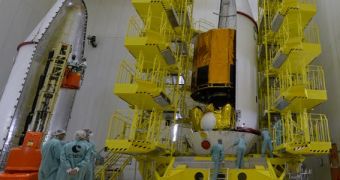Officials with the European Space Agency (ESA) announce that the Gaia space observatory, a mission that will survey 1 billion stars within the Milky Way over the next five years, was successfully installed inside its payload fairing on Friday, December 13.
The mission, one of ESA's most ambitious to date, is scheduled to launch into space at 09:12 GMT on December 19, from the Soyuz Launch Complex at the Kourou Spaceport, in French Guiana, South America. The observatory will be carried into space aboard a Russian-built Soyuz ST-B medium-lift rocket, outfitted with a Fregat-MT upper stage.
Earlier today, engineers at Kourou successfully completed the intricate maneuver of fitting the folded Gaia inside the payload fairing of the Fregat-MT, marking the completion of ground operations. The fitted ensemble is now ready to begin ground testing ahead of launch next Thursday.
Once in space, Gaia will be inserted in the L2 Lagrangian orbital point, where it will maintain the same orientation and position in regards to the Earth-Sun-Moon system. L2 is located around 1.5 million kilometers (932,000 miles) away from our planet, beyond the orbit of the Moon.
Data collected by Gaia on the positions of 1 billion stars of the Milky Way's 100 billion will be used to create a 3D map of the entire galaxy, ESA anticipates.

 14 DAY TRIAL //
14 DAY TRIAL //